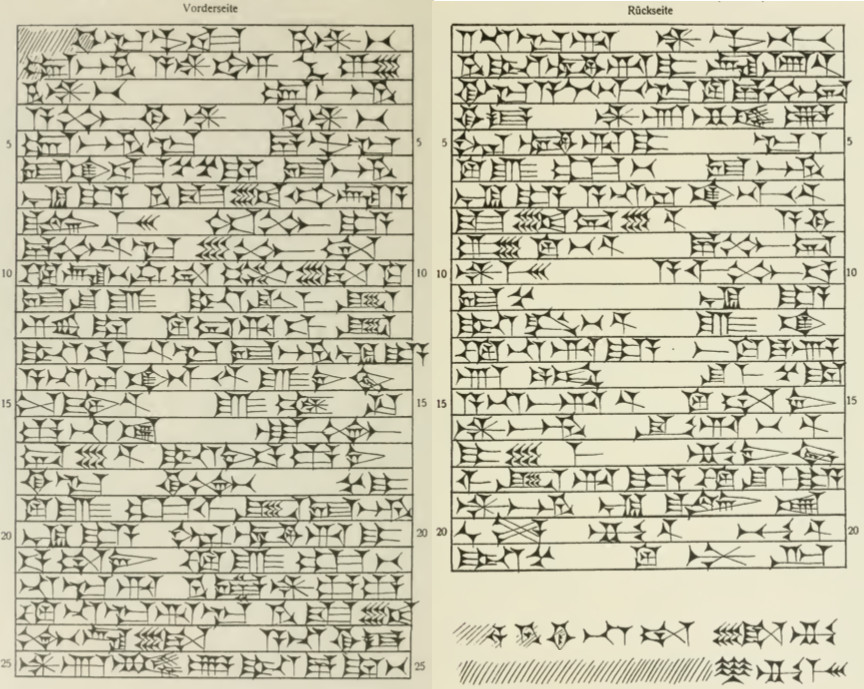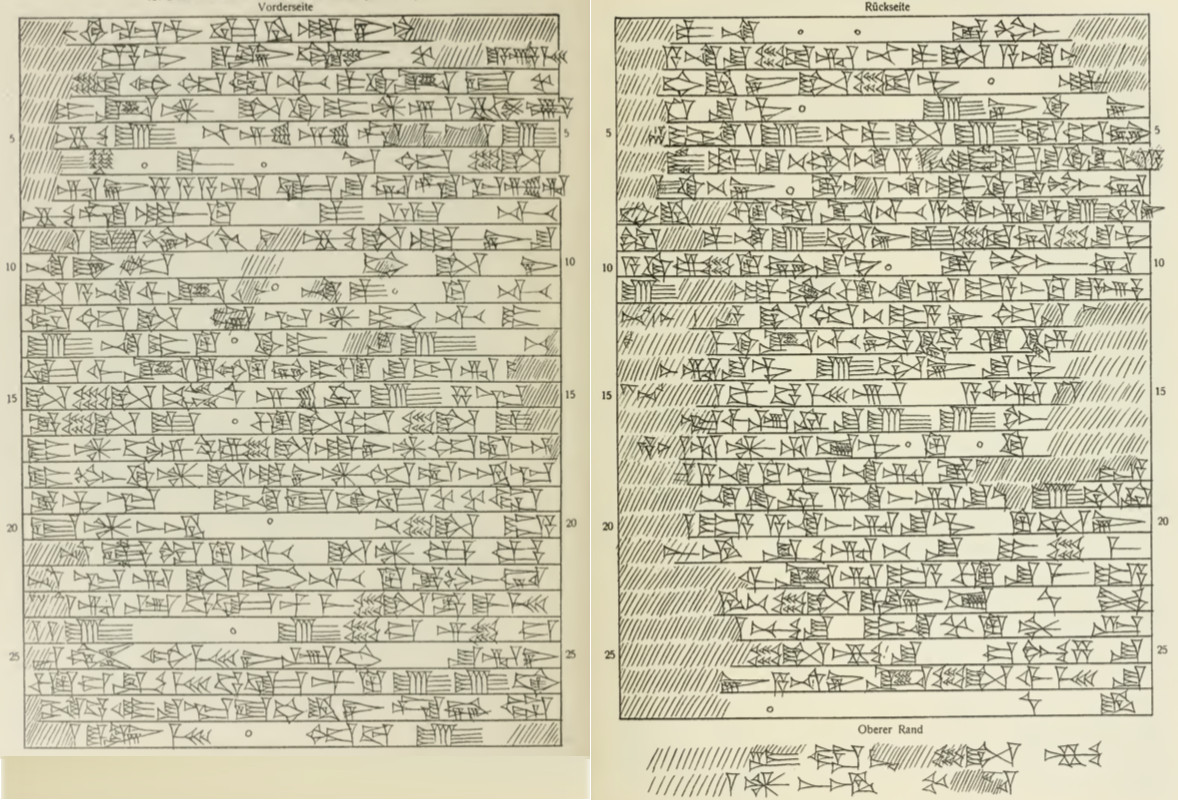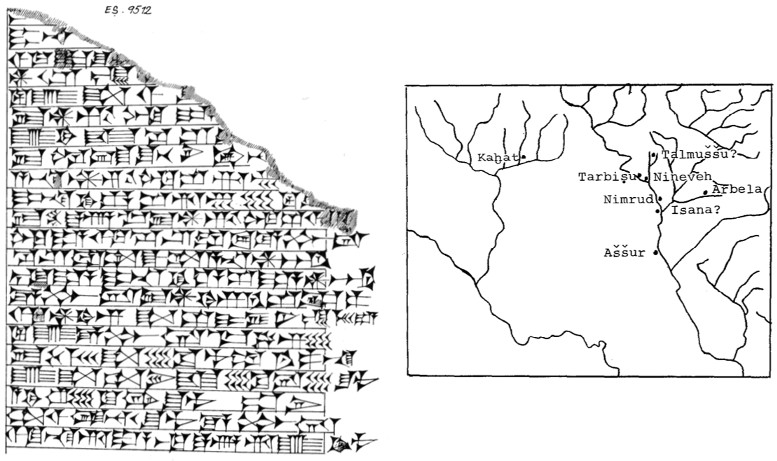Browse the RIAo Corpus [http://oracc.museum.upenn.edu/riao/pager/]
01
02
03
04
05
06
07
08
09
10
11
12
13
14
15
16
17
18
19
01
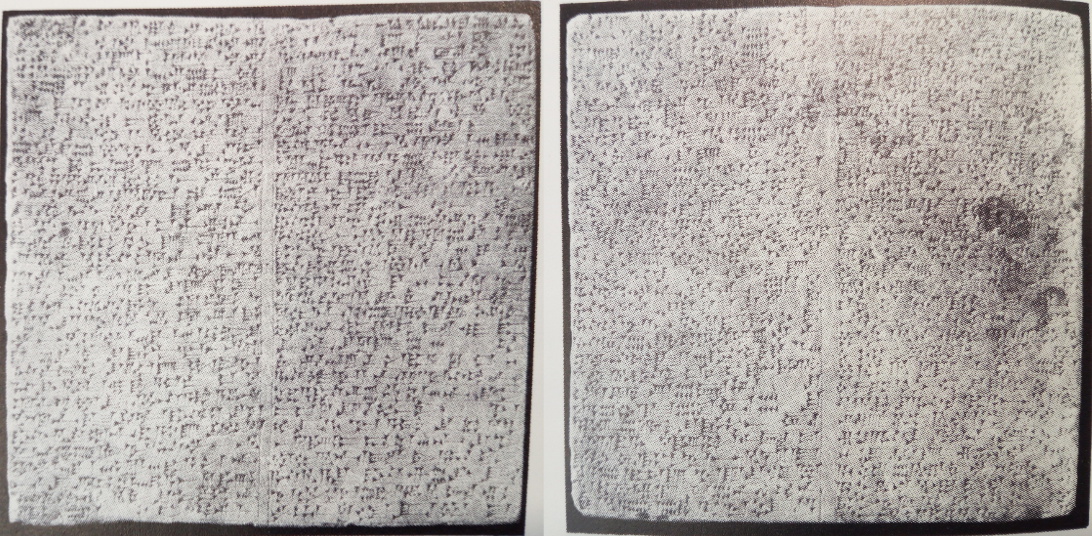
Andrae, WEA2 p. 168 (ex. 1)
One of the longest among the Assyrian royal inscriptions, this text
is preserved in more than twenty exemplars, all inscribed in two
columns on both faces of square and rectangular stone tablets. One
notes the use of a temporal clause to introduce the detailed military
descriptions; this was an expedient taken from Sumerian literature
used by the author of the inscription to harmonize the military
narrative in the traditional form of the inscriptions. However, the
rhetorical device was misused and resulted in syntactical problems
that make uneasy the comprehension for the reader. The building
section records the complete restoration – the hand of Shalmaneser
being particularly "tangible" on the remains of the temple, according
to Andrae (WEA2 p. 165) – of Eḫursagkurkurra, the Aššur temple, after a fire.
Access the composite text [http://oracc.museum.upenn.edu/riao/Q005789/] of Shalmaneser I 01.
Sources:
(1) Ist EȘEM 06688 (Ass 00859)
(2) Ist EȘEM 09510 (Ass 00860)
(3) Ist EȘEM 06689 (Ass 00983)
(4) Ist EȘEM 06694 (Ass 00886)
(5) Ist EȘEM 09511 (Ass 00785)
(6) Ist EȘEM 06690 (Ass 00783)
(7) Ist EȘEM 09512 (Ass 17313)
(8) Ass 00890 + Ass 00894
(9) Ass 00787 + Ass 00919 + Ass 01782 + Ass 01782a + Ass 01782b
(10) Ist EȘEM - (Ass 00994)
(11) Ass 00908
(12) Ass 17229
(13) Ass 16944
(14) Ist EȘEM - Ass 00786
(15) Ist EȘEM -
(16) Ass 02159
(17) Ass 00784
(18) Ist EȘEM 06233
(19) Ist EȘEM 06225
(20) Ist EȘEM 06231 Ass 00831)
(21) Ist EȘEM 06230 (Ass 04823)
(22) Ist EȘEM 06228 (Ass 04693)
Possible Sources:
(1*) Ass 00875
(2*) Ass 00981
(3*) Ass 01120
Bibliography
1904 Andrae, MDOG 21 pp. 23, 29, 32, 34, and 38; 22 p. 18 (exs. 1-6, 8, 17, 20, provenance)
1911 Messerschmidt, KAH 1 nos. 13, 69, and pp. 74-76 (ex. 1, copy; exs. 2-6, 8-11, 16-17, vars. listed)
1911-12 Luckenbill, AJSL 28 pp. 184-93 (exs. 1-6, 8-11, 16-17, edition)
1912 Delitzsch, AL5 pp. 133-34 (study)
1915 Bezold, HKA pp. 20-27 (exs. 1-6, 8-11, 16-17, edition)
1926 Weidner, IAK XXI 1 (exs. 1-13, 16-17, edition)
1926 Luckenbill, ARAB 1 §§112-23 (exs. 1-6, 8-11, 16-17, translation)
1926-27 Luckenbill, AJSL 43 p. 216 (exs. 1-13, 16-17, study)
1930 Schott, OLZ 33 887 (exs. 1-13, 16-17, study)
1932-33 Schwenzner, AfO 8 p. 40 (exs. 1-13, 16-17, study)
1955 Haller, Heiligtümer pp. 38-39 (exs. 1-13, 16-17, translation)
1967 Salvini, Nairi pp. 24-26 (exs. 1-13, 16-17, study of lines 22-46 and 98-99)
1968 Ellis, Foundation Deposits p. 174 (exs. 1-13, 16-17, study of lines 141-45)
1972 Grayson, ARI 1 LXXVII 1 (exs. 1-13, 16-17, translation)
1977 Andrae, WEA2 p. 168 (ex. 1, photo)
02
Several clay cones from Ashur are inscribed with a text describing
the rebuilding and addition of two towers to the temple of Aššur,
after a fire destroyed it (see, text no. 1). The two towers are one at the
Kalkal Gate and the other at the entrance to the forecourt of the god
Nunnamnir, when entering the Mušlālum (or Step) Gate."
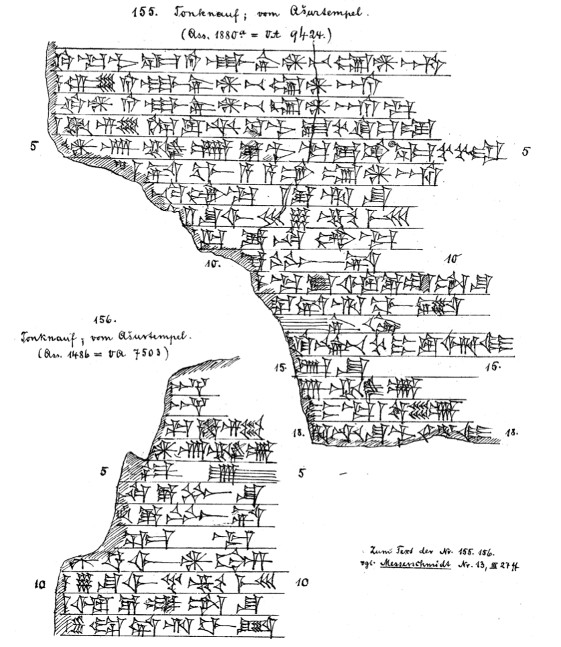
KAH 2 nos. 155-156 (exs. 4-5, copy)
Access the composite text [http://oracc.museum.upenn.edu/riao/Q005790/] of Shalmaneser I 02.
Sources:
(1) Ist EȘEM 06717 (Ass 01803)
(2) VA 08250 (Ass 18614)
(3) VA Ass 02073 (Ass 20366)
(4) VA 07503 (Ass 01486)
(5) VA 09424 (Ass 01880a)
(6) Ist A 03615 (Ass 18535)
(7) Ist A 03569 (Ass 14540)
(8) Ist A 03571 (Ass 15209)
(9) Ist A 03416 (Ass 05166)
(10) 1856-09-09, 0197 + 1856-09-09, 0200
(11) Ist A 03374 (Ass 02807)
(12) Ist A 03608 (Ass 18453a–d)
(13) Ist A 03586 (Ass 16296)
(14) BM 120166 (1928-02-11, 0096)
(15) Ist A 03384 (Ass 03431)
(16) MLC 01303
(17) Ist A 03418 (Ass 05229)
(18) Ist A 03372 (Ass 02670)
(19) Ist A 03651
(20) VA Ass 02078 (Ass 23010)
(21) Ist A 03396 (Ass 03920)
(22) Ist A 03422 (Ass 05655)
(23) Ist A 03423 (Ass 05656)
(24) Ist A 03587 (Ass 16467)
(25) Ist A 03419 (Ass 05230)
(26) Ist A 03591 (Ass 16763)
(27) Ist A 03592 (Ass 17142)
(28) Ist A 03373 (Ass 02728)
(29) Ist A 03503 (Ass 10252)
(30) Ist A 03585 (Ass 16179)
(31) Ist A 03595 (Ass 17166)
(32) Ist A 03625 (Ass 18820)
(33) Ist A 03413 (Ass 04884)
(34) Ist A 03593 (Ass 17155)
(35) Ist A 03390 (Ass 03681)
(36) Ist A 03542 (Ass 12158a)
(37) Ist A 03344 (Ass 01076)
(38) Ist A 03431 (Ass 05904)
(39) Ist A 03624 (Ass 18786)
(40) VA Ass 02077 (Ass 18272)
(41) Ist A 03618 (Ass 18654)
(42) Ist A 03395 (Ass 03904)
(43) Ist A 03533 (Ass 11684)
(44) Ist A 03386 (Ass 03594a)
(45) VA Ass 02072 (Ass 11506)
(46) Ist A 03420 (Ass 05296)
(47) Ist A 03401 (Ass 04375)
(48) Ist A 03391 (Ass 03730a)
(49) Ist A 03610 (Ass 18459)
(50) Ist A 03602 (Ass 17852)
(51) Ist A 03642
(52) Ist A 03606 (Ass 18439)
(53) Ist A 03370 (Ass 02783)
(54) Ist A 03605 Ass 18391)
(55) Ist A 03414 (Ass 04943)
(56) Ist A 03616 (Ass 18627)
(57) Ist A 03387 Ass 03626)
(58) Ist A 03623 (Ass 18762)
(59) Ist A 03366 (Ass 01880b + Ass 01880d)
(60) Ist A 03394 (Ass 03858)
(61) Ist A 03399 (Ass 04184a)
(62) Ist A 03342 (Ass 00327)
(63) Ist A 03652
(64) Ist A 03417 (Ass 05202)
(65) Ist A 03424 (Ass 05730k)
(66) Ist A 03597 (Ass 17285)
(67) Ist A 03609 (Ass 18456)
Bibliography
1900 Scheil, RT 22 pp. 155-56 (ex. 16, copy, edition)
1904 Andrae, MDOG 25 pp. 18-21 and 32 (exs. 1, 4, provenance)
1922 Schroeder, KAH 2 nos. 155-156 (exs. 4-5, copy)
1923 Clay, BRM 4 no. 14 (ex. 16, copy)
1926 Weidner, IAK XXI 2 (exs. 1, 4-6, 8-9, 12-13, 17-18, 22-23, 25, 39, 41, 45-46, 50, 52-53, 58, 66, edition)
1926-27 Luckenbill, ARAB 1 p. 41 n. 1 (ex. 16, translation); 2 pp. 502-503 (same exs. as Weidner, translation)
1930 Schott, OLZ 33 887 (same exs. as Weidner, study)
1932-33 Schwenzner, AfO 8 pp. 119-23 (same exs. as Weidner, study)
1972 Grayson, ARI 1 LXXVII 2 (same exs. as Weidner, translation)
1982 Rost, FuB 22 nos. 16-20 (exs. 2-3, 20, 40, 45, copy)
1984 Donbaz and Grayson, RICCA nos. 32-93 (exs. 1, 6-9, 11-13, 15, 17-19, 21-39, 41-44, 46-67, study)
03
A stone tablet from Ashur bears another account of the
reconstruction of the Ashur temple and the construction of two towers,
locateda one at the
Kalkal Gate and the other at the entrance to the forecourt of the god
Nunnamnir, when entering the Mušlālum (or Step) Gate."
Access the composite text [http://oracc.museum.upenn.edu/riao/Q005791/] of Shalmaneser I 03.
Source: Ass 02708
Bibliography
1904 Andrae, MDOG 25 pp. 63-64 (provenance)
1911 Messerschmidt, KAH 1 no. 14 and p. 76 (copy)
1911-12 Luckenbill, AJSL 28 pp. 194-95 (edition)
1915 Bezold, HKA pp. 28-29 (edition)
1926 Weidner, IAK XXI 3 (edition)
1926 Luckenbill, ARAB 1 §124 (translation)
1926-27 Luckenbill, AJSL 43 pp. 216-17 (study)
1931 Schott, ZA 40 p. 17 and n. 4 (study)
1932-33 Schwenzner, AfO 8 pp. 40-45 (study)
1972 Grayson, ARI 1 LXXVII 3 (translation)
04
A further text - with nos. 1-3 - dealing with the works at the
temple of Aššur. This text seems to appear on two exemplars, but the
fragmentary condition fo the second leaves space for uncertainty. The
two exemplars are a stone and a clay tablet.
Access the composite text [http://oracc.museum.upenn.edu/riao/Q005792/] of Shalmaneser I 04.
Sources:
(1) VAT 08773 (Ass 02105)
(2) Ist EȘEM 09519 (Ass 04752)
Bibliography
1904 Andrae, MDOG 25 pp. 40-42 (ex. 1, provenance)
1911 Messerschmidt, KAH 1 no. 15 and p. 76 (ex. 1, copy)
1911-12 Luckenbill, AJSL 28 pp. 196-99 (ex. 1, edition)
1915 Bezold, HKA pp. 29-31 (ex. 1, edition)
1926 Weidner, IAK XXI 4 (exs. 1-2, edition)
1926 Luckenbill, ARAB 1 §§125-26 (ex. 1, translation)
1926-27 Luckenbill, AJSL 43 p. 217 (exs. 1-2, study)
1930 Schott, OLZ 33 887 (exs. 1-2, study)
1933-34 Schwenzner, AfO 9 pp. 41-44 (exs. 1-2, study)
1961 Borger, EAK 1 pp. 64-65 (exs. 1-2, study)
1969 van Driel, Aššur p. 18 (exs. 1-2, study)
1972 Grayson, ARI 1 LXXVII 4 (exs. 1-2, translation)
05
Another text recording the rebuilding of the temple of Aššur, is
inscribed on a stone tablet, discovered at the south-east gate of the
main court of the temple.
Access the composite text [http://oracc.museum.upenn.edu/riao/Q005793/] of Shalmaneser I 05.
Source:Ist EȘEM 09517 (Ass 17450)
Bibliography
1910 Andrae, MDOG 44 p. 34 (provenance)
1926 Weidner, IAK XXI 5 (edition)
1969 van Driel, Aššur p. 17 (study)
1972 Grayson, ARI 1 LXXVII 5 (translation)
06
When Shalmaneser I restored the temple of the Assyrian Ištar at
Ashur, he found five exemplars of Adad-nārāri I's inscription
no. 15 dealing with the same temple. He
then modelled after it his cown commemorative inscription, which has
been retrireved on three stone tablets retrieved in Ashur.
However, it will be only his son, Tukuti-Niniurta I (text no. 11 [/riao/Q005847/]), who will finish the
restoration works and redeposite Adad-nārāri's tablets to their original place.
Access the composite text [http://oracc.museum.upenn.edu/riao/Q005794/] of Shalmaneser I 06.
Sources:
(1) Ist EȘEM 09518 (Ass 19699)
(2) Ist EȘEM 06700 (Ass 00928)
(3) Ass 12746
Bibliography
1922 Schroeder, KAH 2 no. 42 (ex. 1, provenance, copy)
1924 Maynard, JSOR 8 pp. 5-6 (ex. 1, translation)
1926 Weidner, IAK XXI 8 (exs. 1-3, edition)
1926 Luckenbill, ARAB 1 §129 (ex. 1, translation)
1935 Andrae, JIT pl. 19b (ex. 1, photo)
1972 Grayson, ARI 1 LXXVII 10 (exs. 1-3, translation)
07
A gold tablet (measuring 34.5 × 24.1 cm) recording work on the
shrine of Ninuaittu/Nunaittu ("The Ninevite Goddess") was found in a container
with two tablets - one gold and one silver - with a similar content
and belonging to Tukultī-Ninurta I (nos. 17).
Access the composite text [http://oracc.museum.upenn.edu/riao/Q005795/] of Shalmaneser I 07.
Source: Ist EȘEM 03763 (Ass 06509)
Bibliography
1922 Schroeder, KAH 2 no. 43 (copy) and p. 126 (provenance)
1924 Maynard, JSOR 8 p. 6 (translation)
1926 Weidner, IAK XXI 9 (edition)
1926 Luckenbill, ARAB 1 §130 (translation)
1926-27 Luckenbill, AJSL 43 p. 217 (study)
1935 Andrae, JIT pp. 51-53 and pl. 24n-o (translation, photo)
1968 Ellis, Foundation Deposits pp. 97-98 and 191 no. 50 (study)
1972 Grayson, ARI 1 LXXVII 11 (translation)
08
A piece of a stone tablet found at Ashur is inscribed with an
inscription recording work on the shrine of Šerua and Dagan.
Access the composite text [http://oracc.museum.upenn.edu/riao/Q005796/] of Shalmaneser I 08.
Source: Ist EȘEM 06878 (Ass 00984)
Bibliography
1908 Andrae, MDOG 21 p. 38 (study)
1926 Weidner, IAK XXI 16A (edition)
1972 Grayson, ARI 1 LXXVII 20 (translation)
09
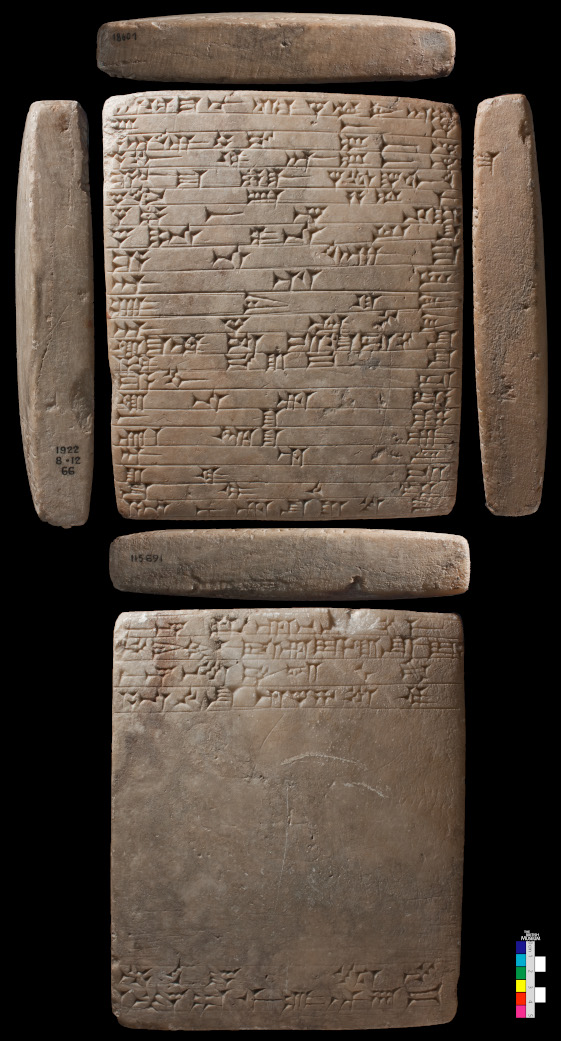
KAH 2 nos. 155-156 (exs. 4-5, copy)cdli photo [https://cdli.ucla.edu/dl/photo/P452095.jpg]
A stone tablet from Ashur records the works on the Libūr-šalḫī
Gate, adjacent to the shrine of the Gate of Aššur.
Access the composite text [http://oracc.museum.upenn.edu/riao/Q005797/] of Shalmaneser I 09.
Source: BM 115691 (Ass 18601)
Bibliography
1922 Schroeder, KAH 2 no. 41 (provenance, copy)
1922 BM Guide p. 65 no. 179 (study)
1924 Maynard, JSOR 8 p. 5 (translation)
1926 Weidner, IAK XXI 13 (edition)
1926 Luckenbill, ARAB 1 §132 (translation)
1926-27 Luckenbill, AJSL 43 p. 217 (study)
1930 Schott, OLZ 33 888 (study)
1932-33 Schwenzner, AfO 8 pp. 37-40 (study)
1955 Haller, Heiligtümer p. 69 (provenance)
1972 Grayson, ARI 1 LXXVII 17 (translation)
1982 Miglus, ZA 72 pp. 270-71 (study)
10
This inscription is preserved on two exemplars, but only one of
them is partly readable, whereas the other is very fragmentary. The
text records work on the palace complex at Ashur.
Access the composite text [http://oracc.museum.upenn.edu/riao/Q005798/] of Shalmaneser I 10.
Sources:
(1) VA 08852 (Ass 13081)
(2) VA - (Ass 07450b)
Bibliography
1908 Andrae, MDOG 38 p. 23 (ex. 1, provenance)
1926 Weidner, IAK XXI 15 (exs. 1-2, edition)
1972 Grayson, ARI 1 LXXVII 19 (exs. 1-2, translation)
11
An inscription dealing with works on the new palace at Ashur was
found on a piece of stone, bored lengthwise discovered by the
ziqqurrat of the Adad temple, north-east of the terrace of the new
palace itself.
Access the composite text [http://oracc.museum.upenn.edu/riao/Q005799/] of Shalmaneser I 11.
Source: Ass 06097
Bibliography
1905 Andrae, MDOG 28 p. 26 (provenance)
1926 Weidner, IAK XXI 14 (edition)
1972 Grayson, ARI 1 LXXVII 18 (translation)
12
A stone tablet fragment from Ashur bears an inscription dealing
with work on a structure associated with the son of the king.
Access the composite text [http://oracc.museum.upenn.edu/riao/Q005800/] of Shalmaneser I 12.
Source: Ass 14697
Bibliography
1926 Weidner, IAK XXI 18 (edition)
1972 Grayson, ARI 1 LXXVII 22 (translation)
13
A piece of clay tablet discovered at the north-east corner of the Nabû
temple is inscribed with a text of which only the introductory and
conlcuding formulae are preserved.
Access the composite text [http://oracc.museum.upenn.edu/riao/Q005801/] of Shalmaneser I 13.
Source: Ist A 00096 (Ass 13001)
Bibliography
1908 Andrae, MDOG 38 p. 21 (provenance)
1926 Weidner, IAK XXI 17 (edition)
1972 Grayson, ARI 1 LXXVII 21 (translation)
14
A fragmentary text on a piece of stone tablet shows an inscription
of which only the introductory formula of Shalmaneser I is preserved.
Access the composite text [http://oracc.museum.upenn.edu/riao/Q005802/] of Shalmaneser I 14.
Source: Ist A - (Ass 01860)
Bibliography
1926 Weidner, IAK p. 158 n. 1 (study)
1972 Grayson, ARI 1 LXXVII 21 (translation)
15
A piece of stone slab discovered in one of
the rooms south-west of the great forecourt of the Aššur temple. The
very fragmentary text inscribed on it has been regarded by
Weidner as an exemplar
of text no. 8, but in RIMA it has been treated separately with a further
note on the fact that there is no evidence of this or even that the
text belonged to Shalmaneser I.
Access the composite text [http://oracc.museum.upenn.edu/riao/Q005803/] of Shalmaneser I 15.
Source: VA - (Ass 05339)
Bibliography
1926 Weidner, IAK XXI 16B (edition)
1972 Grayson, ARI 1 LXXVII 20 (translation)
16
A slab stone from Ashur discovered in the main court of the Aššur
temple bears an inscription that almost duplicates text no. 1. Here, following RIMA, is only
edited the passage that significantly differs, and which records works
on several cities within the kingdom: Ashur, Talmuš, Arbail, Kaḫat and
Isana (see also the main introduction to this king.)
Access the composite text [http://oracc.museum.upenn.edu/riao/Q005804/] of Shalmaneser I 16.
Source: Ist EȘEM 09512 (Ass 17313)
Bibliography
1983 Donbaz and Frame, ARRIM 1 p. 1-5 (copy, edition)
17
Numerous clay cones discovered at Nineveh bear an inscription of Shalmaneser I recording his renovation of the temple of the goddess Ištar. The king undertook the restorations since the building had been damaged by an earthquake that took place during the reign of Aššur-uballiṭ I [http://oracc.museum.upenn.edu/riao/thekingdomofassyria13631115bc/ashuruballiti/index.html]. Samsī-Addu I [http://oracc.museum.upenn.edu/riao/fromsamsiaddutomittanicilent18081364bc/samsiaddui/index.html] and Aššur-uballiṭ I [http://oracc.museum.upenn.edu/riao/thekingdomofassyria13631115bc/ashuruballiti/index.html] are credited as previous builders. The cones are now housed in the British Museum (London).
Access the composite text [http://oracc.museum.upenn.edu/riao/Q005805/] of Shalmaneser I 17.
Sources:
(1) BM 123446 (1856-09-09, 0181 + 1932-12-10, 0389)
(2) BM 123456 (1932-12-10, 0399)
(3) 1856-09-09, 0187
(4) BM 123473 + BM 128341 (1932-12-10, 0416 + 1932-12-10, 0598)
(5) Sm 2115
(6) 1856-09-09, 0164
(7) BM 122673 + BM 122674 (1930-05-08, 0106 + 1930-05-08, 0107)
(8) BM 122666 (1930-05-08, 0099)
(9) BM 139290 (1932-12-10, 0744)
(10) BM 121137 (1929-10-12, 0146)
(11) BM 123511 (1932-12-10, 0454)
(12) BM 128367 (1932-12-10, 0624)
(13) BM 122677 (1930-05-08, 0110)
(14) BM 122670 (1930-05-08, 0103)
(15) BM 128185 (1929-10-12, 0841)
(16) BM 128208 (1929-10-12, 0864)
(17) BM 122669 (1930-05-08, 0102)
(18) BM 128203 (1929-10-12, 0859)
(19) BM 128388 (1932-12-10, 0645)
(20) K 14921
Bibliography
1870 3 R pl. 3 nos. 3-5 (exs. 1, 3, 6, copy)
1875 G. Smith, Assyrian Disc. pp. 248-49 (exs. 1, 3, 5-6, translation)
1904 King, Tn. pp. 123-32 (exs. 1, 3, 5-6, edition), pp. 167-69 (exs. 1, 3, 5-6, copy), and p. 175 (ex. 20, copy)
1926 Weidner, IAK XXI 10 (exs. 1, 3, 5-6, 20, edition)
1926-27 Luckenbill, ARAB 1 §§133-36; 2 p. 503 (exs. 1, 3, 5-6, translation)
1926-27 Luckenbill, AJSL 43 p. 217 (exs. 1, 3, 5-6, study)
1929 Thompson, Arch. 79 p. 134 and pl. XLVII no. 122I (ex. 10, copy, edition)
1932 Thompson, AAA 19 pp. 94-95, pls. LXXI-LXXX nos. 92 (ex. 7), 94 (ex. 12), 100 (ex. 14), 106 (ex. 8), 117 (ex. 13), 119 (ex. 4), 135 (ex. 19), 144 (ex. 9), 175 (ex. 15), 180 (ex. 17), 227 (ex. 11), 251 (ex. 1), 252 (ex. 4), and 256 (ex. 2) (copy, edition)
1961 Borger, EAK 1 pp. 49-50 (exs. 1-15, 17, 19-20, edition)
1972 Grayson, ARI 1 LXXVII 13 (exs. 1-20, translation)
1975 Borger, HKL 2 p. 20 sub EAK 1 pp. 49-50 (study)
18
Five clay cones from Nineveh bear an inscription of Shalmaneser I commemorating his restoration of the walls and ziggurat of the Ištar temple, both of which had suffered damage during an earthquake (reign of Aššur-uballiṭ I [http://oracc.museum.upenn.edu/riao/thekingdomofassyria13631115bc/ashuruballiti/index.html]. The objects are now in London (British Museum).
Access the composite text [http://oracc.museum.upenn.edu/riao/Q005806/] of Shalmaneser I 18.
Sources:
(1) BM 128337 (1932-12-10, 0594)
(2) Rm 2, 606
(3) BM 123455 (1932-12-10, 0398)
(4) Sm 2125
(5) BM 123459 (1932-12-10, 0402)
Bibliography
1904 King, Tn. pp. 133, 169 (ex. 4, copy, edition), pp. 135-36, and 173 (ex. 2, copy, edition)
1926 Weidner, IAK XXI 11 (exs. 2, 4, edition)
1926 Luckenbill, ARAB 1 §§137-38 (exs. 2, 4, translation)
1930 Schott, OLZ 33 887-88 (exs. 2, 4, study)
1932 Thompson, AAA 19 pp. 93-94 (exs. 1-4, edition) and pl. LXXVII no. 170 (exs. 1 and 3 combined, copy)
1961 Borger, EAK 1 p. 59 n. 1, p. 62 n. 2, p. 63 n. 1, and p. 69 n. 3 (exs. 1-4, study)
1968 Lambert and Millard, Cat. pp. 27 and 61 (exs. 1, 3, 5, study)
1972 Grayson, ARI 1 LXXVII 12 (exs. 1-5, translation)
19
A badly damaged clay cone from Nineveh preserves parts of the first seven lines of a building inscription of Shalmaneser I. Like the previous two texts, it records that king's restoration of the Ištar temple Emašmaš. The object is housed in the British Museum (London).
Access the composite text [http://oracc.museum.upenn.edu/riao/Q005807/] of Shalmaneser I 19.
Source: BM 122664 (1930-05-08, 0097)
Bibliography
1932 Thompson, AAA 19 p. 102 and pl. LXXI no. 91 (copy, study)
1961 Borger, EAK 1 p. 50 (study)
1968 Lambert and Millard, Cat. p. 17 (study)
1972 Grayson, ARI 1 LXXVII 14 (translation)


